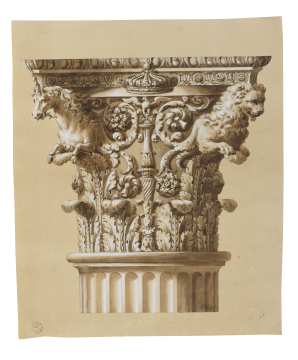
Browse
Reference number
Purpose
Aspect
Signed and dated
- Undated, probably 1762
Medium and dimensions
346 x 310
Hand
Notes
The capital was also engraved in Rome by Domenico Cunego (1727(9) - 94) for The Works in Architecture of Robert and James Adam, London, 1773-79, part V, pl.2, as after James Adam, 1767: its caption there reads 'We have formerly, that the ancients used very frequently to indulge themselves in compositions of fancy; introducing into their capitals and entablatures the various symbols of those divinities to whom they erected temples. A licence of the same has been hazarded here. The lion and unicorn support the angles of the abacus, which is adorned with the regal crown, the collar of the order of the Garter, and acorns in ovolo. The sceptre and dove, the rose and thistle, fill the intermediate space between the leaves of the acanthus. The lion and unicorn are also alternatively interwoven in the foliage of the freeze, and the oak-leaf and acorn again adorn the upper torus of the base.'
James Adam intended the capital for the columns of the portico of his Parliament House scheme, and he referred to them in 1762 as 'for the great portico of my project' (see National Archives of Scotland, Edinburgh, Clerk of Penicuik Collection, GD18/4936). Giovanni Battista Piranesi (1720-1778), in his Trofei di Ottarviano Augusto, 1753, offered several antique sources for such a design, especially that of San Lorenz fuori delle Mura. The capital also appears in the portrait of James Adam of 1763 by Antonio Zucchi (1726-95).
Level
Exhibition history
The Adam Brothers in Rome: Drawings from the Grand Tour, Sir John Soane's Museum, London, 25 September 2008 - 14 February 2009
Sir John Soane's collection includes some 30,000 architectural, design and topographical drawings which is a very important resource for scholars worldwide. His was the first architect’s collection to attempt to preserve the best in design for the architectural profession in the future, and it did so by assembling as exemplars surviving drawings by great Renaissance masters and by the leading architects in Britain in the 17th and 18th centuries and his near contemporaries such as Sir William Chambers, Robert Adam and George Dance the Younger. These drawings sit side by side with 9,000 drawings in Soane’s own hand or those of the pupils in his office, covering his early work as a student, his time in Italy and the drawings produced in the course of his architectural practice from 1780 until the 1830s.
Browse (via the vertical menu to the left) and search results for Drawings include a mixture of Concise catalogue records – drawn from an outline list of the collection – and fuller records where drawings have been catalogued in more detail (an ongoing process).

